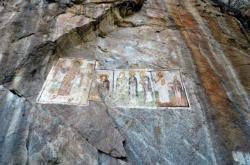INSTITUT SUPERIEUR D'ANTHROPOLOGIE
INSTITUTE OF ANTHROPOLOGY
ONLINE COURSES / COURS A DISTANCE
SPRING TERM : APRIL 2016
REGISTER NOW
TURQUIE –  Yatağan - Ancient frescoes of Jesus Christ and a number of saints, as well as rock graves around them, will serve tourism within the scope of a new geopark project in the southwestern province of Muğla’s Yatağan district. The frescoes, thought to have been made by secret Christian worshippers around 1,500 years ago, will be taken under protection and promoted with the project.
Yatağan - Ancient frescoes of Jesus Christ and a number of saints, as well as rock graves around them, will serve tourism within the scope of a new geopark project in the southwestern province of Muğla’s Yatağan district. The frescoes, thought to have been made by secret Christian worshippers around 1,500 years ago, will be taken under protection and promoted with the project.
http://www.hurriyetdailynews.com/Default.aspx?pageID=238&nid=97005&NewsCatID=375
ROYAUME UNI –  Dandaleith - A rare stone carved by the Picts, the ancient people of north and north-east Scotland, is to go on public display for the first time from today at Elgin Museum. Described as a national treasure, the Dandaleith Stone is a Pictish monument which was uncovered by a farmer in a field at Dandaleith, near Craigellachie, almost two years ago when he broke his plough on the one tonne granite boulder. The stone, made of solid pink granite boulder, has incised decoration on two adjoining faces. The other two faces show no obvious signs of carving. The official description states: “Face 1 is incised with a large crescent, with crescent and V-rod below. Face 2 is incised with a mirror case symbol, with notch rectangle and Z-rod below. “The stone may be unique in having two pairs of symbols carved on the same orientation on two adjoining faces.” Dr David Clarke, former Keeper of Archaeology at the National Museum of Scotland, said: “The presence of two sets of symbols on a single stone is itself a very unusual feature relative to the corpus of symbol-bearing stones, but the presence of two sets of symbols on adjacent faces may be unique. “The corresponding orientation of the sets of symbols is also a very unusual feature.”
Dandaleith - A rare stone carved by the Picts, the ancient people of north and north-east Scotland, is to go on public display for the first time from today at Elgin Museum. Described as a national treasure, the Dandaleith Stone is a Pictish monument which was uncovered by a farmer in a field at Dandaleith, near Craigellachie, almost two years ago when he broke his plough on the one tonne granite boulder. The stone, made of solid pink granite boulder, has incised decoration on two adjoining faces. The other two faces show no obvious signs of carving. The official description states: “Face 1 is incised with a large crescent, with crescent and V-rod below. Face 2 is incised with a mirror case symbol, with notch rectangle and Z-rod below. “The stone may be unique in having two pairs of symbols carved on the same orientation on two adjoining faces.” Dr David Clarke, former Keeper of Archaeology at the National Museum of Scotland, said: “The presence of two sets of symbols on a single stone is itself a very unusual feature relative to the corpus of symbol-bearing stones, but the presence of two sets of symbols on adjacent faces may be unique. “The corresponding orientation of the sets of symbols is also a very unusual feature.”
http://www.thenational.scot/news/national-treasure-museum-to-unveil-rare-pictish-dandaleith-stone.15544
FRANCE –  Angoulême – Le donjon et la tour des Valois, derniers vestiges du château comtal angoumoisin, se sentiront-ils moins seuls? À leur pied, sous le bitume éclaté de la cour de l’hôtel de ville, les archéologues de l’Institut national de recherches archéologiques préventives (Inrap) viennent de dégager les bases d’une tour de l’ancien château, ainsi que les murs de bâtiments qui y étaient adossés. "On connaissait l’existence de la tour, construite entre 1230 et 1250 et démolie au moment de la construction de l’hôtel de ville par Paul Abadie au XIXe siècle, lance Adrien Montigny, le responsable du chantier. Les murs sont en revanche inédits. On peut grossièrement les dater entre les XIIIe et XVIe siècles." Pas de pavés sous le bitume, ni de trace de fossé défensif qui aurait pu être creusé par les comtes d’Angoulême entre le château et la ville. Au-delà de la tour et des murs mis au jour, les archéologues ont trouvé des fragments de tuiles et céramiques antiques, une épaisse couche de terre noire laissant penser à d’anciens grands jardins, et moins visibles, en dessous, des traces d’une muraille qui pourrait dater de la cité antique du IIIe siècle.
Angoulême – Le donjon et la tour des Valois, derniers vestiges du château comtal angoumoisin, se sentiront-ils moins seuls? À leur pied, sous le bitume éclaté de la cour de l’hôtel de ville, les archéologues de l’Institut national de recherches archéologiques préventives (Inrap) viennent de dégager les bases d’une tour de l’ancien château, ainsi que les murs de bâtiments qui y étaient adossés. "On connaissait l’existence de la tour, construite entre 1230 et 1250 et démolie au moment de la construction de l’hôtel de ville par Paul Abadie au XIXe siècle, lance Adrien Montigny, le responsable du chantier. Les murs sont en revanche inédits. On peut grossièrement les dater entre les XIIIe et XVIe siècles." Pas de pavés sous le bitume, ni de trace de fossé défensif qui aurait pu être creusé par les comtes d’Angoulême entre le château et la ville. Au-delà de la tour et des murs mis au jour, les archéologues ont trouvé des fragments de tuiles et céramiques antiques, une épaisse couche de terre noire laissant penser à d’anciens grands jardins, et moins visibles, en dessous, des traces d’une muraille qui pourrait dater de la cité antique du IIIe siècle.
http://www.charentelibre.fr/2016/03/26/fouilles-la-base-d-une-tour-du-chateau-comtal-mise-au-jour,3024998.php